|
1.
CENTRAL AND WEST AFRICA
Log shortage reported in Cameroon
The immediate challenge in the milling sector is an acute
log shortage say producers. Some major sawmills report
virtually empty log yards forcing reduced shifts or
complete shutdowns. It has been reported that at least
three sawmills in Douala have temporarily ceased
operations and relocated outside the city limits to free up
land for urgent housing construction. Overall industry
sentiment is one of frustration and uncertainty as raw
material supplies remain critically low.
Heavy rains across the country have stalled harvesting
operations, exacerbating an existing log shortage. The
onset of the rain season has brought widespread
downpours, creating impassable conditions on laterite
roads. Transport delays of up to two days from forest areas
to mills have reduced overall throughput.
Rail services continue without major disruption. Container
availability at Douala and Kribi ports remain adequate,
however, berthing issues can delay loading by up to a
week. Shipping lines report Cameroon now loading
roughly 75% of Gabon’s timber volumes, exhasterbating
port congestion.
With 28 presidential candidates now declared ahead of
October elections uncertainty is dampening investment
appetite. Ministerial departures to contest the vote
underscore the volatility. Operators have adopted a “keep
the mills running” stance, deferring serious capital
expansions until the post-election outlook stabilises.
Rain wreaking havoc on road repairs and log haulage
in Gabon
Despite it being the ‘official’ dry season, persistent daily
showers in Libreville and rain further north near the
Cameroon border are wreaking havoc on road repairs and
log haulage. Through late July, operations in the bush
remain constrained by lingering rains as mentioned above,
with many peeling and plywood plants in the Nkok special
economic zone running a single shift.
Persistent downpours continue to render laterite access
roads between Okondja, Makokou, Lastourville and Lope
virtually impassable causing trucks to abandon certain
routes altogether. Operators are pinning their hopes on the
‘true’ dry spell, expected in August, to rebuild log stocks
but anticipate that unhindered timber transport will not
resume until around September.
Despite quiet markets in India and China, demand for
Okoume logs continues with prices around CFA70,000 per
cubic metre delivered to Nkok rising to CFA80,000 for
top-grade logs.
The rail company SETRAG struggles to meet shippers’
needs despite a ministerial directive to prioritise timber. A
fresh infusion of Central African Development Bank funds
should accelerate track and bridge repairs and SETRAG
has already begun replacing wooden sleepers with
concrete.
The two Turkish power-ships have largely stabilised
Libreville’s electricity supply following government
intervention. Outages have fallen from daily multi-hour
cuts to perhaps one brief disruption each week, though
some night-time interruptions of two to three hours persist.
Mill operators report no significant shortages of spare
parts or other critical inputs but they remain wary of
contractual disputes with certain public agencies.
Owendo Port continues to handle timber dispatches
without container shortages though berthing delays of two
to three days recur when grain vessels and roll-on/roll-off
ships occupy quay space. Overall port charges and
customs duties remained unchanged through July.
Since January, every bundle of sawn timber must carry
GPS-verified origin data and as of July forestry inspectors
have begun rigorous cross-checks of both bundle tags and
truck loads in the bush. Any sawntimber truck longer than
13m or carrying logs under minimum diameters (e.g.
Okoume below 70 cm) is subject to immediate seizure. A
new weighbridge facility 150 km from Libreville is due to
become operational in August eliminating most remaining
avenues for non-compliant transport.
The traders in the Middle East report growing competition
from Brazilian pine which is exerting downward pressure
on Okoume prices but orders for Andoung and Iroko
remain healthy.
Heavy rain continues to disrupt road transport in
Republic of Congo
Producers report market activity is relatively quiet. In the
north of the Republic of Congo heavy rains continue to
disrupt overland shipments bound for Kribi and Douala
compounding already weakened production due to muted
Chinese demand. Meanwhile, the southern basin remains
dry but output levels have yet to recover as long‐term
contracts and slow markets keep sawmills operating well
below capacity.
No significant changes were reported in harvesting
volumes or log throughput this period. Road and rail links
to Pointe-Noire continue to operate with spare-part
availability for logging machinery remaining adequate.
Market demand for Congolese sawn timbers and veneers
remains steady but very subdued.
There have been no new forestry regulations, ministerial
decrees or policy announcements affecting timber
production or exports since the last update. With no
significant developments in the forestry and transport
sectors industry participants anticipate that conditions will
remain stable into early August.
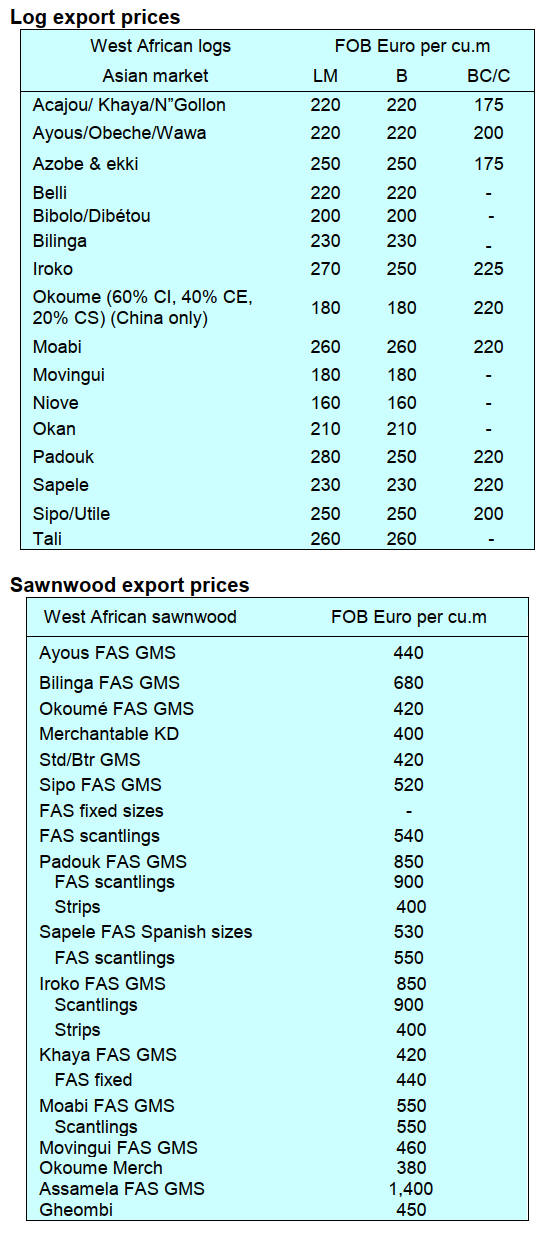
Through the eyes of industry
The latest GTI report lists the challenges identified by the
private sector in the Republic of Congo and Gabon.
See: https://www.itto-
ggsc.org/static/upload/file/20250716/1752653872183995.pdf
2.
GHANA
Eurobond holders paid
Ghana has made significant progress in fulfilling its debt
service obligations with two debt payments totalling about
US$700 million paid to Eurobond holders in the first half
of 2025 according to the Minister of Finance, Dr. Cassiel
Ato Forson.
When delivering the 2025 Mid-Year Budget Review in
Parliament Dr. Forson affirmed the Government’s
commitment to restoring debt sustainability and
maintaining investor confidence.
The Minister further indicated that GH¢9.8 billion in
domestic coupon payments were also made to Domestic
Debt Exchange Programme (DDEP) bondholders in the
first half of 2025.
Ghana’s total public debt has declined significantly from
GH¢726.7 billion at the end of December 2024 to GH¢613
billion as of end of June 2025. The decline translates into a
negative 16% rate of debt accumulation, improving the
country’s debt-to-GDP ratio from 62% at the end of 2024
to 44% as of June 2025.
Meanwhile, the Monetary Policy Committee (MPC) of the
Bank of Ghana (BoG) has announced that the economy
has seen some significant improvements with a positive
outlook as all macro-economic indicators showed good
results.
President John Mahama, in advance of the recent Budget
Statement, revealed that Ghana’s international reserves
had increased to six months of import cover from the 4.7
months quoted by the Bank of Ghana in April this year..
See: https://www.graphic.com.gh/news/general-news/govt-pays-
700m-to-eurobond-holders-ghc9-8bn-to-domestic-investors.html
and
https://mofep.gov.gh/sites/default/files/budget-statements/2025-
Mid-Year-Fiscal-Policy-Review.pdf
Teak accounted for 85% of sawnwood exports
According to the Timber Industry Development Division
(TIDD) of the Forestry Commission, wood product
exports from Ghana during the first five months of 2025
totalled 96,416 cu.m valued at Euro44.84 million
compared to 111,999 cu.m and Euro51.44 million in the
same period in 2024.
This represents a decline of 14% and 13% in volume and
value respectively. During the period, exports of all timber
products declined except for billets and sliced veneer.
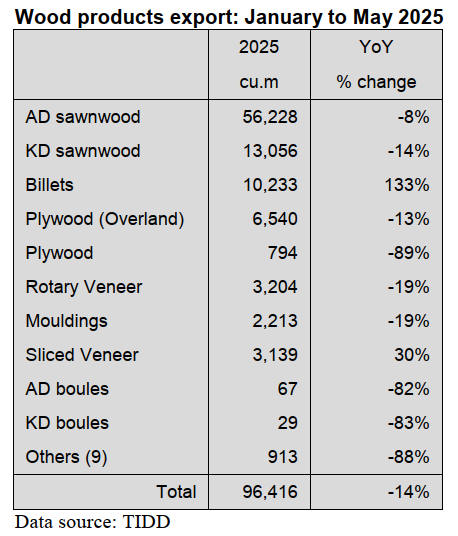
Air and kiln dried sawnwood together contributed 69,284
cu.m (72%) of the total export volume for the period
January to May 2025. While for the same period in 2024
these products contributed 76,242 cu.m (68%) of the total
export volume.
The data showed that sawnwood exports in 2025
accounted for 69% of the total value of wood exports for
the period January-May while the contribution of billets
and plywood to regional market exports were 7% and 6%
respectively, 15 other products contributed the balance of
the total exported value.
Of the total sawnwood exports, the kiln-dried sawnwood
volume was four times more than that of the air-dried
sawnwood during the period. There was a marked
difference in the range of species exported depending on
whether the timber was kiln or air dried.
Wawa dominated exports of air dried sawnwood for the
period but for kiln dried sawnwood teak accounted for
85% of the total.
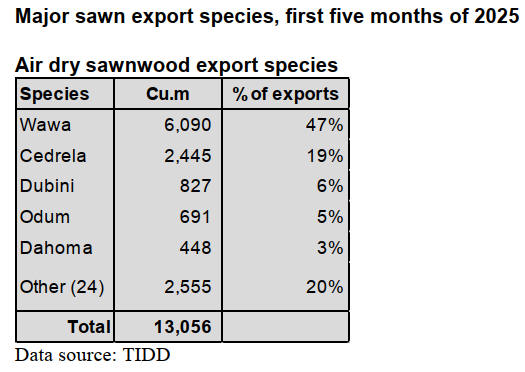 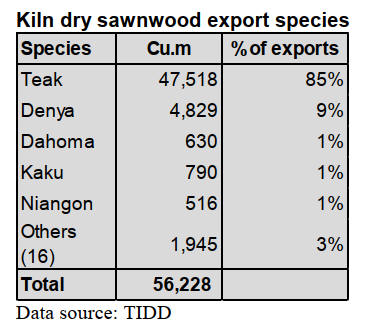
A drop in export volumes of plywood (-88%), kiln dried
boules (-83%), air dried boules (-81%) and rotary veneer
(-19%) could be attributed to the inadequate domestic
supply of logs.
Parliament ratifies Timber Utilisation Contracts (TUCs)
Ghana’s Parliament has ratified Timber Utilisation
Contracts (TUCs) for some 131 companies for a
sustainable timber trade in the country in accordance with
article 268 of the 1992 Constitution.
The Ministry of Lands and Natural Resources convened a
high-level consultative meeting on the ratification of the
TUCs bringing together representatives from key
Ministries, Non-governmental organisations and
stakeholders in the timber industry.
The meeting discussed the status of the TUC ratification
process which was before Cabinet for approval and also
reviewed progress on the issuance of Forest Law
Enforcement, Governance and Trade (FLEGT) license.
In his remarks, Innocent Haligah, speaking on behalf of
the Sector Minister Hon. Emmanuel Armah-Kofi Buah,
welcomed participants and highlighted ongoing efforts by
the Ministry to meet critical deadlines for the issuance of
the FLEGT license.
The TUC ratification and FLEGT licensing processes are
seen as vital components of Ghana's commitment to
sustainable forest management and legal timber trade
under international agreements.
The consultative meeting provided the platform for
stakeholders to share insights, raise concerns and align
strategies toward achieving a transparent and accountable
forestry sector.
See:https://gna.org.gh/2025/07/parliament-ratifies-five-mining-
lease-agreements-timber-utilisation-contracts-for-131-
companies/
Company claims it faces collapse as illegal logging
depletes forest reserves
A major company in the newly-created Ahafo Region has
warned it faces collapse from illegal mining and logging
activities as encroachers are fast depleting the forest
reserve that feeds raw material to the company.
The General Manager of the company raised the alarm
over the devastating impact of illegal logging on the
company’s operations, during a working visit by the Ahafo
Regional Minister, Charity Gardiner.
In a related development, the University Teachers
Association of Ghana (UTAG), which is deeply concerned
about the continued destruction of Ghana’s environment
through illegal mining activities, has threatened a
nationwide strike if there is no action to address the
country’s ‘galamsey’ threats.
See: https://www.adomonline.com/ayum-timber-company-faces-
collapse-as-illegal-logging-depletes-forest-reserves/
and
https://www.myjoyonline.com/utag-gives-mahama-government-
3-month-ultimatum-to-end-galamsey-or-face-strike/
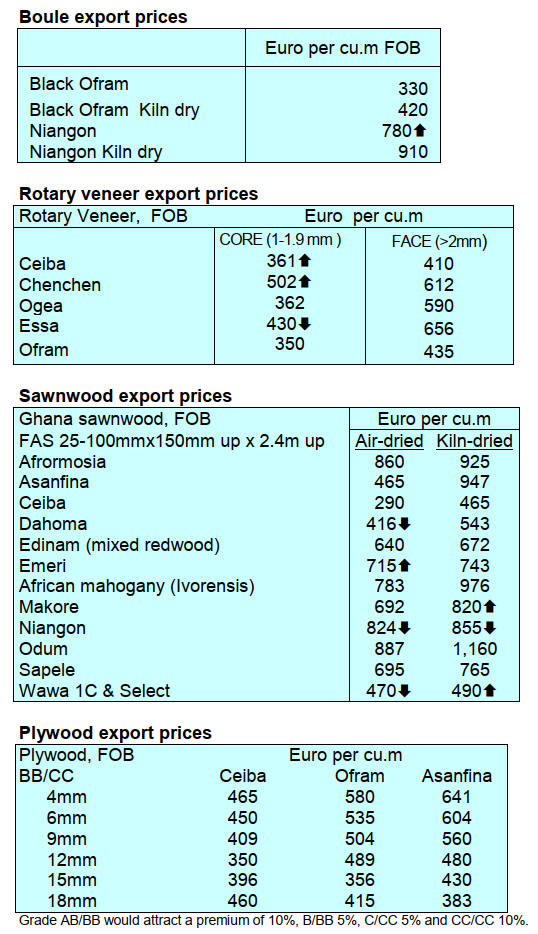 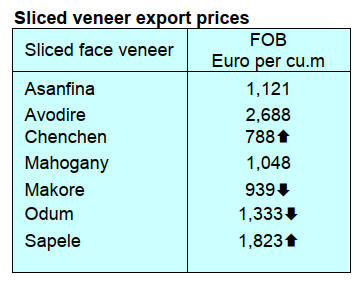
Through the eyes of industry
The latest GTI report lists the challenges identified by the
private sector in Ghana.
See: https://www.itto-
ggsc.org/static/upload/file/20250716/1752653872183995.pdf
3. MALAYSIA
Overall trade growth
The recorded cumulative trade value increase by 4.8% to
RM1.465 trillion in the first half of 2025 reflecting the
strength and resilience of Malaysia’s external trade
position.
The country’s trade surplus surged to RM8.59 billion in
June compared to RM759.9 million in May 2025 marking
the 62nd consecutive month of surplus since May of 2020.
The key factors driving exports in June included palm oil
and palm oil-based agricultural products which recorded
double-digit growth for 15 consecutive months.
See:
https://theborneopost.pressreader.com/article/282153592318217
Muar Furniture Association - outlook tough
The furniture sector is struggling under mounting
international and domestic pressures leading to some long-
standing manufacturers shutting down after decades of
operation. Muar Furniture Association (MFA) president,
Steve Ong, said some businesses had ceased operation
over the past two years, including several original
equipment manufacturers as they felt the future of the
industry was not promising.
“The situation has become increasingly tough for local
furniture makers who are already grappling with policies
that burden businesses. Aside from having to deal with the
expanded sales and service tax (SST), the US-imposed
tariffs on Malaysian exports are an added burden for those
focused on the American market,” he said.
Ong, who’s Association represents more than 800
members, pointed out that high electricity tariffs and
mandatory the Employees Provident Fund (a national
retirement fund) contributions for foreign workers are also
adding to the pressure on businesses.
He said MFA has continued to call for a temporary
suspension of the SST, electricity tariff hike and EPF
contribution for foreigners.
Ong also urged the government to provide financial
incentives or assistance to help companies transition
effectively.
He said that while the government is encouraging
automation many industry players are hesitant to make the
change. “If local furniture makers are forced to shut down
or relocate overseas it will not only affect jobs but the
entire supply chain will suffer,” he said.
The MFA held a dialogue session with industry recently to
listen to their concerns. Many participants, including a
furniture maker who has been in the business for over four
decades, lamented about the “policies that are not
business-friendly” which are hurting the economy.
Malaysian Furniture Council president, Desmond Tan,
who is also MFA executive adviser, said the council
received over 180 petitions from industry players about
the untimely policies. He added that the council had
submitted a petition to Plantation and Commodities
Ministry over the matter.
See:
https://www.thestar.com.my/news/nation/2025/07/24/furnitures-
tough-outlook#goog_rewarded
Value of timber trade
Malaysia’s total value of wood and wood products trade
(exports and imports) reached RM 9.95 billion in the first
four months of this year, said Sarawak Timber Industry
Development Corporation (STIDC) General Manager,
Zainal Abidin Abdullah. Last year, timber exports earned
RM22.9 billion, a solid almost 5% increase from the
previous year.
He said exports contributed RM7.183 billion, signifying
strong demand for Malaysian timber products while
imports stood at RM 2.767 billion, reflecting healthy
domestic use and a well-connected supply chain.
Wooden furniture took the lead in exports bringing in
RM3,083 million, followed by plywood (RM742.5
million), sawn timber (RM582.5 million) and fibreboard
(RM210 million). Zainal also pointed out material
shortages as ‘a significant hurdle’, with Malaysia
importing up to 60% of its raw materials such as timber,
hardware and fabrics.
Zainal continued saying that Sarawak’s timber export
earnings reached RM2.84 billion last year, a slight drop
from RM3.14 billion in 2023.
“Sarawak, despite its rich timber resources, exports raw
wood rather than finished products thus limiting value-
added opportunities. In addition, our industry relies
heavily on foreign workers which affect skills retention
and innovation. Locally, there is a shortage of skilled
craftsmen and designers, which slows productivity and the
adoption of new technologies”, he said.
On STIDC, Zainal said a comprehensive ‘Furniture
Industry Blueprint’ had been developed to map out a clear,
strategic pathway for the sector’s growth encompassing
product development, supply chain strengthening and
market expansion.
See:
https://mail.google.com/mail/u/0/?tab=rm&ogbl#inbox/WhctKL
bfNvkzcqDsfmkPmfhwKNZdfpQjnsLZwWDDVJlWjchjQvfXK
qGXVmJmQMmlxhDwFBb
Training future foresters
Nineteen postgraduate students from Universiti Malaysia
Sabah (UMS) completed a four day intensive training
workshop aimed at empowering the younger generation to
understand sustainable forest management and
biodiversity conservation.
The high-impact training, GIS & Statistical Analysis
Training Workshop was held through a special
collaboration between UMS and the Sabah Environmental
Trust (SET), a local non-governmental organisation.
Dr. Elia Godoong, a Senior Lecturer at the Faculty of
Tropical Forestry, UMS and one of the workshop trainer
on statistics said the participants were introduced to both
technical and practical skills essential for forest
management and biodiversity conservation.
The participants also learned to use advanced geospatial
technologies such as Geographic Information Systems
(GIS), as well as big data analytics and statistical
modeling approaches using R software.
See:
https://mail.google.com/mail/u/0/?tab=rm&ogbl#inbox/WhctKL
bfMvLSsWZhZPrPFdntqvwcmjDbgMdlVdkMjMLsHrqRLkHvp
zlJZGhcdldHMMTwKbB
Certification Standard review
The Malaysian Timber Certification Council (MTCC) is
conducting a scheduled review of two Standards under the
Malaysian Timber Certification Scheme (MTCS). This
review aims to ensure continued relevance, alignment with
international requirements and incorporation of national
and stakeholder interests. Feedback is invited to help
strengthen the MTCS by improving the standards’ clarity,
feasibility and effectiveness.
The review of the Malaysian Timber Certification Scheme
(MTCS) standards, particularly MTCS ST 1002:2021
Malaysian Criteria and Indicators for Sustainable Forest
Management and MTCS ST 1003:2021 Group Forest
Management Certification – Requirements, is a crucial
process to ensure their continued relevance, credibility,
and alignment with international best practices in
sustainable forest management and certification.
See: https://mtcc.com.my/mtcs-standard-review-initial-
feedback-on-existing-standards/
4.
INDONESIA
USITC found hardwood and decorative
plywood
imports have caused "material injury"
The US International Trade Commission (USITC) has
made a preliminary ruling favoring domestic hardwood
and decorative plywood (HWDP) producers. This decision
comes after an anti-dumping petition was filed against
HWDP exports from Indonesia, Vietnam and China.
The USITC found sufficient indications that these imports
have caused "material injury" to the US HWDP industry.
This initial ruling, made on 3 July, is expected to be
finalised later this year and follows a petition submitted by
the Coalition for Fair Trade in Hardwood Plywood.
See: https://agroindonesia.co.id/itc-plywood-indonesia-rugikan-
produsen-dalam-negeri-as/
Furniture exports face challenges despite IEU-CEPA
The Indonesian Furniture and Craft Industry Association
(Himki) sees significant potential in the European Union
(EU) furniture market valued at an annual US$58.4 billion
especially in light of the, soon to be finalised, Indonesia-
European Union Comprehensive Economic Partnership
Agreement (IEU-CEPA).
However, Himki Chairman Abdul Sobur said” this
potential cannot fill the gap in expected declines in exports
to the US due to tariffs”.
The EU market presents significant challenges due to strict
sustainability and due diligence standard and this requires
time for local producers to adapt, invest and reposition
their products focusing on high value-added items with
strong designs and non-price competitiveness.
Despite these hurdles, Sobur acknowledges the benefits of
the IEU-CEPA. These include zero tariffs for most
Indonesian furniture and craft products entering the EU
enabling more competitive market access.
The agreement also provides incentives for industrial
transformation towards environmentally friendly practices
and certification. Furthermore, it opens opportunities for
technical cooperation, joint ventures with European brands
and strengthens Indonesia's position as an alternative
supply chain for Europe.
The (IEU-CEPA) could increase furniture exports to the
EU by 15% to 25% within the first three years of its
implementation depending on the industry's preparedness,
said Sobur.
See: https://www.msn.com/id-id/berita/other/pengusaha-mebel-
sebut-pasar-eropa-menantang-meski-ada-ieu-cepa/ar-
AA1IFFV5?ocid=BingNewsVerp
and
https://www.msn.com/id-id/berita/other/ieu-cepa-berpotensi-
dongkrak-ekspor-mebel-ke-eropa-hingga-25/ar-
AA1IzA5l?ocid=BingNewsVerp
Tariffs a burden for SME manufacturers
Despite a new 19% reciprocal tariff imposed by US
President Donald Trump, the Indonesian Furniture and
Craft Industry Association (Himki) anticipates moderate
growth of 5-7% annually in furniture exports to the US.
Himki acknowledges that the 19% tariff remains a burden
for Indonesian manufacturers, particularly small and
medium enterprises.
Export growth is not expected to match pre-trade war
levels as US buyers are now more cost-conscious and
exploring alternative markets.
See:
https://ekonomi.bisnis.com/read/20250717/257/1893665/tarif-
trump-19-ekspor-furnitur-ri-ke-as-diproyeksi-tumbuh-moderat.
Agroforestry skills for forest communities
Indonesian Minister of Manpower, Yassierli, highlighted
the critical role of agroforestry skills in improving the
economic well-being of families in forest communities.
Speaking in Padang City at the opening of the "Human
Resources Empowerment in the Forestry Sector for
Agroforestry Farmers" training, Minister Yassierli stated
that the goal is for village communities near forest areas to
gain strong agroforestry skills. This will enable them to
contribute to their families' economies without resorting to
deforestation.
See: https://en.antaranews.com/news/365885/minister-promotes-
agroforestry-skills-for-forest-communities-growth
Indonesia taps social forestry to boost food security
Indonesia's Minister of Forestry, Raja Juli Antoni, has
highlighted the social forestry policy as a key strategy to
enhance national food security. He emphasised that this
effectively links environmental conservation with
grassroots economic development.
This initiative aims to boost the forestry sector's
contribution to food self-sufficiency and directly improve
the welfare of forest farmers.
The Minister expressed the government's openness to
collaborate with stakeholders to ensure sustainable
forestry practices while strengthening the sector's role in
food security and local livelihoods.
See: https://en.antaranews.com/news/365365/indonesia-taps-
social-forestry-to-boost-food-security
Addressing degraded forests
The Ministry of Forestry reports that Indonesia faces a
significant challenge with 12.7 million hectares of critical
or degraded forest land, out of 120.5 million hectares of
forest area.
Deputy Minister, Sulaiman Umar Siddiq, highlighted that
this degradation negatively impacts food security, water
quality, bio-diversity and exacerbates climate change.
To combat this, the Ministry is implementing the Forestry
and Other Land Uses (FOLU) Net Sink programme which
focuses on four key strategies: preventing deforestation,
promoting sustainable forest management and
conservation, protecting and restoring peatlands, and
enhancing carbon sequestration.
Furthermore, the Ministry has made strides in
rehabilitation and restoring 2 million hectares of forests
land between 2015 and 2024. This effort, coupled with
Integrated Forest Fire Management, has led to a notable
reduction in forest and land fires.
The government is utilising both domestic and
international funding for reforestation, fire prevention and
bolstering its Social Forestry Programme. The Ministry is
also providing free seedlings and encourages public
participation in a range of forest restoration activities,
including critical land rehabilitation, reforestation and
preventing forest degradation.
See:
https://lestari.kompas.com/read/2025/07/09/120643986/lahan-
kritis-capai-12-juta-hektare-kemenhut-beberkan-rencana-
mengatasinya.
https://forestinsights.id/indonesia-dorong-restorasi-lahan-
sebagai-kunci-pembangunan-kehutanan-inklusif/
US tariff cut eases impact on economy
Indonesia's National Economic Council (DEN) Chairman,
Luhut Binsar Pandjaitan, announced that a reduction in the
US tariff rate on Indonesian products from 32% to 19% is
expected to significantly boost Indonesia's economy.
Pandjaitan emphasised that this tariff arrangement is not a
one-sided concession but rather a strategy for mutual
benefit aiming to open investment opportunities, drive
technology transfer and increase the competitiveness of
Indonesian products.
Economic simulations conducted by DEN project that the
19% tariff rate could lead to a 0.5% growth in Indonesia's
GDP, largely due to an anticipated increase in investment
as global companies move manufacturing to Indonesia.
DEN views this tariff reduction as a crucial opportunity
for Indonesia to accelerate its deregulation agenda and
reduce domestic logistics and production costs.
See:https://en.antaranews.com/news/367009/us-tariff-cut-to-
boost-indonesias-economy-den
and
https://www.thejakartapost.com/world/2025/07/19/indonesia-not-
out-of-woods-despite-us-eu-deals.html
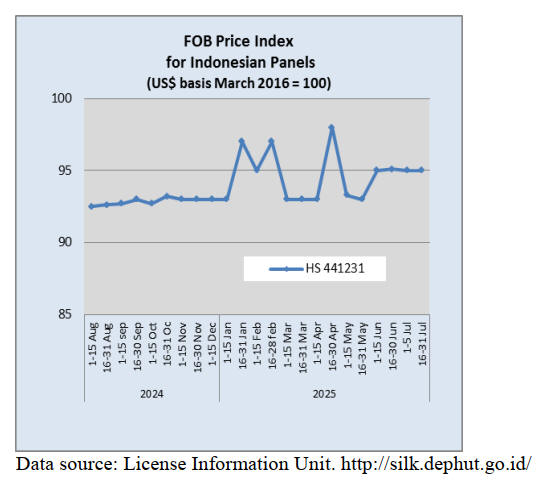
5.
MYANMAR
Myanmar prepares to negotiate tariffs
Major General Zaw Min Tun, spokesperson for the State
Administration Council, announced plans to negotiate with
the United States following the US announcement of a
40% tariff on Myanmar’s exports starting 1 August.
Speaking through state media, Zaw Min Tun expressed
optimism for “positive negotiations and mutually
beneficial outcomes.” The Military Council has indicated
readiness to send a high-level delegation to discuss tariff
adjustments.
The proposed visit to the US comes amid longstanding
tensions following the 2021 suspension of the Trade and
Investment Framework Agreement (TIFA) by the United
States. The agreement, signed in 2013, enabled structured
dialogue on trade and labour practices.
Under the TIFA Myanmar had committed to uphold core
labour rights aligned with International Labour
Organization (ILO) standards.
Myanmar is waiting for a response from the US on
whether talks will proceed with Myanmar facing both
economic and diplomatic pressure to protect its export
channels.
See - https://burmese.dvb.no/post/716131
and
https://burmese.dvb.no/post/713734
Currency stablisation efforts
The Myanmar government has moved to curb imports in a
bid to stabilise the country’s volatile exchange rate which
reached up to nearly 6,000 MMK to the US dollar in 2024.
Import restriction, especially those aimed at stabilising the
exchange rate, can have far-reaching
consequences including on the timber industry which has
facing challenges of market access.
The main impact will be on imports of machinery, spare
parts, chemicals and packaging materials since many
operations rely on imported items.
The strategy, aimed at preserving foreign currency
reserves comes amid mounting pressure on the Kyat and a
widening trade deficit. However, critics say that limiting
imports without a comprehensive assessment of
commodity pricing and inflation risks could exacerbate
economic fragility.
See - https://www.ogresearch.com/news/myanmar-a-unique-
system-of-multiple-parallel-exchange-rates, https://www.scm-
legal.com/post/cbm-allows-exporters-to-keep-more-foreign-
currency and https://www.iges.or.jp/en/pub/forests-timber-
sources-and-supply-chains-myammar-opportunities-and-
constraints-ensure-legal
Decline in FDI
Myanmar’s foreign direct investment (FDI) plummeted in
the first quarter of the 2025–26 fiscal year despite recent
government efforts to attract new investments. Official
figures show that Myanmar received only US$40.8
million in FDI between April and June, just one-third of
the US$147.9 million recorded during the same period the
previous year.
Data from the Directorate of Investment and Company
Administration (DICA) shows that investment was
concentrated in just three of the 12 permitted
sectors: manufacturing US$35.8 million, livestock and
fisheries US$2.5 million and services US$2.6 million.
China remained the largest foreign investor during the
period contributing US$13.5 million, followed
by Thailand (US$10.5 million), Hong Kong (US$10
million), and Singapore (US$4.7 million). Smaller
investments came from Japan, South Korea and Taiwan
P.o.C.
In a bid to boost economic activity, the Myanmar
Investment Commission (MIC) approved 35 new
investment projects during its latest meeting on July 17.
See: https://burmese.dvb.no/post/715215 and https://burmese.dv
b.no/post/714889
6.
INDIA
Cost of raw materials
rising
The correspondent reports domestic demand is stable but
subdued and the cost of raw materials is rising but
companies are not able to increase prices due to slow
demand. Ocean Freight and the exchange rate is stable, he
reports.
India and the United States have concluded five rounds of
negotiations for the proposed Bilateral Trade Agreement,
negotiations continue.
The Indian Standards Institute (BIS) is restructuring the
quality standards for various panel products. When the
new Standards are released they will be reported.
The correspondent emphasised an article below on how
the plywood industry is experimenting with new timbers
for core veneer.
Kerala State earned US$162 million from teak
The Times of India has reported Kerala State harvested of
over 6.75 lakh (0.675 million) trees including teak,
rosewood and sandalwood from its forests since 2016. The
auction of teak alone generated more than Rs 1,393 crore
(US$162 million) in revenue for the State according to
information tabled in the assembly by the forests and
wildlife department.
The figures reflect only trees whose felling is regulated
and done with the Departments clearance including teak,
rosewood, ebony and sandalwood
Most revenue came from the auction of teak with
rosewood and sandalwood auctions also adding to the
revenue. While the state earned US$162 million from teak
timber alone it earned another US$9.30 million as tax,
including GST, forest development tax and income tax.
In effect, the teak timber sales alone fetched
approximately US$256 million for the State in a span of
nine years.
The forest department also auctions sandalwood
trees.Though the quantity is less than teak sandalwood is
in high demand, including from public sector companies
outside the State like Karnataka Soaps.
Clarifying rules for private landowners, Forest Department
data presented to the assembly also stated that under the
Kerala Promotion of Tree in Non-Forest Areas Act, 2005
the felling of trees such as teak and rosewood from non-
forest lands is still covered under the forest
department regulation, except in some land categories. The
2011 rules framed under this Act govern the approval
process.
However, even private landowners are prohibited from
felling sandalwood trees, even if standing on their land.
Only the Forest Department is allowed to cut sandalwood
trees and after auctions the proceeds are given to the
landowner after deducting costs be around 30% of the
proceeds.
See:
https://timesofindia.indiatimes.com/city/thiruvananthapuram/kera
la-govt-fells-6-75-lakh-trees-in-forests-in-9-yrs-teak-sale-alone-
fetches-rs-2200-
crore/articleshow/121343206.cms#:~:text=Bengaluru%20Heavy
%20Rainfall-
,Kerala%20govt%20fells%206.75%20lakh%20trees%20in%20fo
rests%20in%209,alone%20fetches%20Rs%202%2C200%20cror
e&text=T'puram%3A%20The%20state%20recorded,its%20fores
t%20ranges%20since%202016.
Pine logs a lifeline for plywood manufacturers
In one of its recent magazines Plyreporter identifies that
imported pine logs have become a lifeline for Indian
plywood manufacturers for core veneer. It has been
reported that plywood industries in Gujarat, Rajasthan,
Haryana and Punjab have been using substantial quantities
of pine logs and their dependency has been shifted to
almost 35% of their total log requirement.
Industry experts suggest that Australian pine logs are more
suitable than others for core veneer although there are
some complaints of bending in pine core veneer
production but that this can be resolved. Uruguay and New
Zealand sourced pine is preferred for block board and
flush doors.
Kandla Port has noted a 17% increase in pine imports.
Importers view that the stable pricing and availability of
logs from Australia, Uruguay, New Zealand, Brazil, South
Africa and other Latin American countries is one of the
reasons demand has risen.
See: https://www.plyreporter.com/article/154110/plywood-
sector-demand-push-up-timber-import-in-india
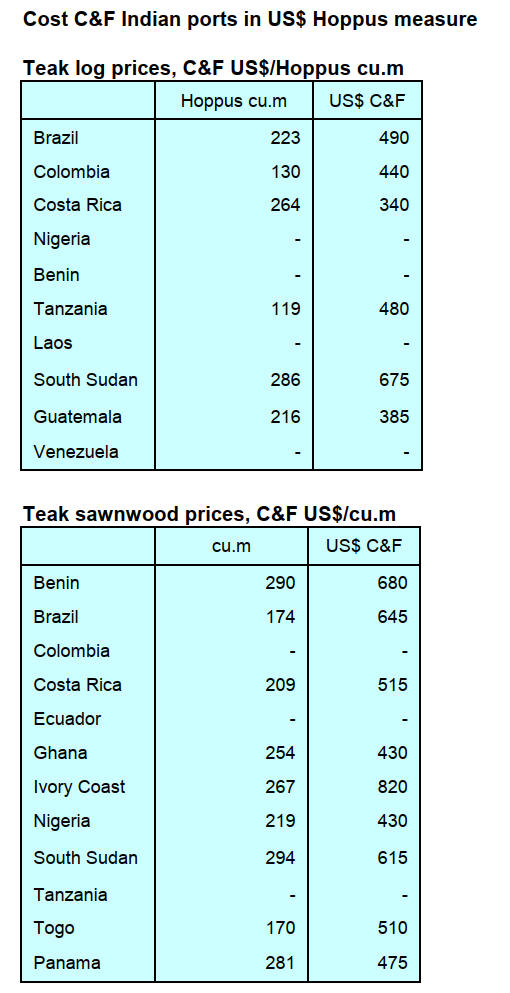

7.
VIETNAM
Value of wood product exports slipped in
May
According to statistics from the Vietnam Customs
Department, W&WP exports in June 2025 reached
US$1.35 billion, up 4% compared to May 2025 and up 6%
compared to June 2024. WP exports contributed US$923.3
million, down 7% compared to May 2025 but up 6%
compared to June 2024.
In the first half of 2025 W&WP exports totalled US$8.2
billion, up 8% compared to the same period in 2024; of
which, WP exports accounted for US$5.6 billion, up 9%.
Vietnam’s W&WP exports to the US in June 2025
amounted to US$778.3 million, down 9% compared to
May 2025 but up 9% compared to June 2024. In the first
six months of 2025 W&WP exports to the US were valued
at US$4.6 billion, up 12% year-on-year.
In June 2025 W&WP exports to Australia stood at
US$12.7 million, down 0.8% compared to June 2024. In
the first half of 2025 total W&WP exports to Australia
earned US$69.6 million, down 4% compared to the same
period in 2024.
Vietnam's W&WP imports in June 2025 amounted to
US$296.2 million, down 2% compared to May 2025
however, it was up 26% compared to June 2024.
In the first half of 2025 total W&WP imports reached
US$1.51 billion, up 20% year-on-year.
Vietnam’s imports of raw wood (log and sawnwood) from
the US in June 2025 continued to increase and reached a
record high of 180,000 cu.m, with a value of US$73.0
million, up 25% in volume and 25.0% in value compared
to May 2025 and up 173% in volume and 165 in value
compared to the same period in 2024.
In the first half of 2025 raw wood imports from the US
reached 598,780 cu.m, worth US$243.48 million, up 86%
in volume and 77% in value compared to the same period
in 2024.
Industry looks towards new horizons
While long considered a strong export sector, local
enterprises are now re-evaluating their strategies to not
only sustain growth but also reposition Vietnamese wood
products on the global trade map. Amid global economic
uncertainties and tightening trade policies, the wood
industry is navigating through significant headwinds.
According to Nguyễn Liêm, chairman of the Bình Dương
Furniture Association, major shifts in trade policies among
importing countries have been felt since early this year.
Although Vietnamese wood products have been sold to
over 160 countries and territories the US remains the
largest market, accounting for nearly 50% of the industry's
export earnings. As a result fluctuation in US regulations
create a ripple effect across the entire industry.
Recently, the US Department of Commerce (DOC)
initiated anti-dumping and countervailing investigations
into plywood imported from Viet Nam.
The action has placed more than 130 Vietnamese timber
processing and exporting companies under scrutiny,
casting uncertainty over one of Vietnam’s most valuable
export category. Despite this, the Ministry of Agriculture
and Environment (MAE) has set an ambitious export goal
for the wood sector in 2025 at US$18 billion.
In the first six months of the year the value of timber and
forest product exports was estimated at over US$8.2
billion, up 9% compared to the same period in 2024.
Yet, global geopolitical tensions and trade policy shifts
continue to threaten the feasibility of this target.
Besides the US, the European Union has also implemented
new technical and legal requirements. Regulations such as
the EU Deforestation Regulation (EUDR), the Carbon
Border Adjustment Mechanism (CBAM) and the
Corporate Sustainability Reporting Directive (CSRD) are
demanding more rigorous environmental and traceability
standards. In Japan, meanwhile, policy changes are
affecting wood pellet exports.
Requirements for transparent, certified sourcing and rising
costs are impacting export competitiveness. In addition to
trade barriers, the domestic wood industry is contending
with challenges in raw material supply.
Vietnam’s wood product exporters are in fierce
competition with major global players such as China,
Malaysia and Indonesia, countries that boast advanced
processing technologies, lower costs and well established
supply chains.
In response to the ongoing US investigations the Vietnam
Timber and Forest Product Association (VIFOREST) has
said it is preparing to participate in the US hearings. The
aim is to clarify that Vietnam’s plywood industry merely
complements, rather than harms, the US domestic sector.
Meanwhile, the MAE is actively coordinating with US
governmental bodies to resolve the issues through
dialogue and technical clarification. Experts have urged
Vietnamese wood businesses to expand into new markets
to reduce over-reliance on traditional buyers.
In particular, such regions as the Middle East, South Asia,
Africa, Latin America and Eastern Europe have emerged
because of their growing demand for furniture,
construction timber and value-added products.
Exploring new markets
Among these potential new markets the Middle East offers
promising opportunities. The United Arab Emirates (UAE)
and Qatar have demonstrated strong demand for luxury
interior and exterior wooden furniture, especially for high-
end hotels and resorts.
Vietnamese enterprises are encouraged to participate in
trade fairs such as Index Dubai, build partnerships with
regional distributors and obtain international certifications
including FSC and PEFC to enhance market credibility.
India, too, is becoming an attractive destination for
Vietnamese wood products. Rapid urbanisation, rising
incomes and a preference for compact, modern furniture
have made online platforms like Amazon India and
Flipkart particularly lucrative. Vietnamese exporters report
strong sales growth in lightweight, space-saving products
suitable for Indian apartments and offices.
The ongoing negotiations for a Free Trade Agreement
(FTA) between Vietnam and India are also expected to
reduce import tariffs from 10% to 5% further boosting
competitiveness. If signed the FTA could lay the
groundwork for deeper economic integration and longer-
term stability in bilateral trade.
Sustainability, technology upgrades
In the face of these pressures, the Vietnamese wood
industry is aiming to elevate its marketing strategy. A
central part of the strategy is ensuring that all wood used,
both domestically and for export, comes from legal,
verifiable sources.
There is a growing push to certify supply chains
with
international standards and improve environmental
transparency.
The MAE has also called for at least 80% of wood
processing and storage facilities nationwide to meet
advanced technological benchmarks. This transition would
allow Vietnamese firms to meet the increasingly complex
technical and environmental demands of foreign
customers.
At the same time, the global shift in supply chains,
including companies looking to diversify away from
Chinese sourcing, offers Vietnamese firms an opening. By
investing in compliance, certification and efficient
logistics, they can become a trusted alternative in the
global wood product market.
According to VIFOREST, with proper orientation and
coordinated efforts between the State and enterprises, the
wood industry can not only overcome current challenges
but also strengthen its global standing.
“We must move beyond survival strategies and enter a
phase of strategic transformation,” the Association said.
With global demand patterns changing and traditional
markets becoming more unpredictable, diversification is
no longer optional, it is vital.
Whether through entering emerging markets, upgrading
processing technology or enhancing legal compliance,
Vietnam’s wood industry is laying the groundwork for a
more resilient and competitive future.
As one of the country’s top export earners, the industry’s
ability to adapt will determine not only its own trajectory
but also Vietnam’s broader reputation in sustainable and
value-added manufacturing.
See: https://vietnamnews.vn/economy/1721573/viet-nam-s-
wood-industry-faces-market-shifts-looks-towards-new-
horizons.html
Wood and wood product exports continued to grow
amid tariff uncertainty
According to the Ministry of Agriculture and Environment
W&WP export values in the first six months of 2025
reached US$8.21 billion, representing an increase of 8.9
per cent compared to the same period in 2024.
The US remained Vietnam’s largest export market,
accounting for 56% of the total exports. Japan and China
followed with market shares of 13% and 10% respectively.
Despite the persistent pressure of tariffs in its key market,
the sector continued to demonstrate its strength, remaining
among the top five agricultural groups with the largest
trade surplus.
First half export performance exceeded expectations
Phùng Quốc Mẫn, Chairman of the Members’ Council of
Bảo Hưng Co., Ltd. and President of the Handicraft and
Wood Industry Association of HCM City, said that
although the US market was affected by new minimum
and countervailing tax regimes, Vietnam’s export
performance in the first half of 2025 exceeded
expectations.
Exports to the US still managed to grow by roughly 6%,
partly due to clients boosting inventory levels ahead of
expected tax enforcement.
Phùng Quốc Mẫn noted that the countervailing tax policy
imposed by the US, though unexpected, was applied
broadly to many exporting nations, not exclusively
Vietnam. As a result, even though the cost of goods
increased, US importers were compelled to continue
placing orders to maintain their supply chains and meet
demand.
Many Vietnamese exporters collaborated closely with
their clients to temporarily share increased costs, ensuring
continuity across the supply chain and maintaining
mutually beneficial relationships.
To mitigate the impact of tariffs, several businesses have
shifted towards market diversification and e-commerce.
Trần Lam Sơn, Deputy General Director of Thiên Minh
Co., shared that e-commerce provides the shortest path
from producer to consumer. While traditional Business-to-
Business (B2B) transactions are significantly affected by
cumulative cost increases due to tariffs, direct-to-
consumer sales via online platforms remain less price
sensitive.
Interior furniture products sold online typically carry
lower value and post-tax price differences that remain
within acceptable levels for end-users. This has resulted in
a growing and stable stream of online orders.
Vietnam completes legal framework for forest carbon
market
The draft decree on forest carbon sequestration and
storage services marks the first attempt to establish a
domestic standard for forest carbon while aligning with
international carbon credit systems. It clearly defines
eligible service providers and buyers, allowing both public
and private entities to supply or purchase credits through
contracts or a national carbon exchange.
Vietnam is pushing forward with efforts to establish a
legal framework for the forest carbon market, aiming to
mobilise new financial resources for sustainable forestry
and climate goals. At a seminar held in Hanoi on 15 July
co-hosted by the Vietnam Forest Owners Association and
Forest Trends, stakeholders discussed a draft decree on
forest carbon sequestration and storage services, which is
currently under review by the Ministry of Agriculture and
Environment.
Speaking at the event, the Director the Department of
Forestry and Forest Protection, Tran Quang Bao, said the
draft is designed to ease administrative procedures and
facilitate forest owners’ participation in carbon trading. He
noted that once adopted, the decree would give carbon
credit holders more autonomy in domestic and
international transactions.
According to Bao, the draft also aims to attract private-
sector involvement to boost forest reserves, which is key
to achieving sustainable forest development and realising
Vietnam’s commitment to emissions reduction.
To Xuan Phuc, a senior expert from Forest Trends, said
the decree is expected to draw financial flows from both
international and domestic private sources via carbon
trading. He noted that planted forests owned by
households should be considered private assets and
relevant regulations and decrees should be expanded to
give them full rights to form joint ventures and
partnerships and participate in the carbon market.
He also recommended that for state-owned forest lands,
once national contribution calculations are completed,
policies should allow cooperation from businesses and
projects to generate carbon credits for trading at home and
abroad. He underlined the importance of transparency in
carbon transactions after Vietnam fulfils its nationally
determined contributions (NDCs).
Nghiem Phuong Thuy of the Department of Forestry and
Forest Protection described the decree as a step toward
translating Vietnam’s net-zero pledge by 2050 into
actionable policies in the forestry sector. It includes
provisions on carbon credit certification, revenue
management, and carbon exchange mechanisms.
She added that the decree clearly defines eligible service
providers and buyers, allowing both public and private
entities to supply or purchase credits through contracts or a
national carbon exchange.
Thuy concluded that the legal framework is essential not
only to meet international transparency requirements but
also to unlock additional funding for forest protection and
development in Vietnam.
See: https://en.vietnamplus.vn/vietnam-completes-legal-
framework-for-forest-carbon-market-post322767.vnp
8. BRAZIL
Timber sector facing severe consequences
from US
tariffs
The Brazilian Association of Mechanically Processed
Timber Industry (Abimci) has expressed deep concern
over the impact of the US government decision to impose
a 50% tariff on Brazilian timber products.
Abimci says this measure severely undermines the
competitiveness of Brazil’s national production chain
which directly employs approximately 180,000 people.
Production is largely concentrated in the three southern
states with about 90% of installed capacity being in the
region, says the Associaition.
Wood product exports to the US reached around US$1.6
billion in 2024 highlighting the importance of the
American market which accounted for an average 50% of
Brazil’s national production. The sector is gripped by
uncertainty.
The industry is already facing serious consequences such
as contract cancellations, suspension of shipments and
partial or total shutdown of production facilities.
Currently, approximately 1,400 containers are enroute to
the US and around 1,100 containers are stuck at Brazilian
ports awaiting shipment, worsening logistical problems
andresulting in commercial losses.
Some companies have already been forced to implement
mandatory worker leave to buy time and preserve jobs
while others are preparing for layoffs. Production is being
reduced across virtually the entire sector and in many
cases it has come to a complete halt.
Considering this critical situation, Abimci has urged the
Federal government to take immediate and coordinated
actions to mitigate the effects of the tariffs.
These include a formal request to extend the
implementation deadline of the tariffs; a recommendation
not to apply reciprocal tariffs that could be interpreted as
retaliation by the US government and the intensification of
diplomatic dialogue with the United States.
Abimci emphasises that this crisis demands high-priority
treatment and the urgent mobilisation of foreign policy
and international trade instruments to safeguard industrial
activity, protect jobs and maintain Brazil’s presence in the
US market.
See: https://abimci.com.br/wp-
content/uploads/2025/07/Nota_Abimci_Taxacao_EUA.pdf
The bio-economy and forest restoration
According to the ‘New Economy for the Brazilian
Amazon’ study coordinated by WRI Brazil, integrating the
bio-economy with forest restoration has the potential to
add up to BRL45 billion to Brazil’s GDP and generate
approximately 830,000 jobs by 2050.
Products such as açaí, Brazil nuts, cupuaçu, camu-camu,
andiroba oil, copaiba oil and honey from native bees
already support value chains rooted in biodiversity-based
economic development, traditional knowledge and the
empowerment of local communities.
The Pan-Amazonian Bio-economy Network, a multi-
sectoral alliance bringing together indigenous
communities, local producers, investors, research centers,
financial institutions and civil society organisations leads
efforts to strengthen the sector.
In mid-July 2025, the Network held the Pan-Amazonian
Action Forum for the Bioeconomy in Leticia, Colombia,
bringing together stakeholders from civil society, the
private sector, governments, indigenous organisations,
international organisations and investors to build alliances
and develop a shared agenda.
Despite the progress of such initiatives, the bioeconomy
remains an underfunded sector in the region. Key barriers
to its expansion include the lack of integrated public
policies, limited access to financing, and insufficient
coordination among stakeholders.
See: https://www.maisfloresta.com.br/bioeconomia-e-
restauracao-florestal-podem-gerar-r-45-bilhoes-no-pib-brasileiro/
Environmental leadership and pressure on Brazil
Brazil began 2025 by taking a strategic role in global
environmental governance, particularly as it prepares to
host the 30th United Nations Climate Change Conference
(COP30) in Belém, Pará, in November. The event will
take place amid a growing climate urgency which is
intensifying demands for tangible progress in multilateral
negotiations.
During the 17th BRICS Summit held on 6 July in Rio de
Janeiro the eleven member countries reaffirmed their
commitment to international instruments such as the Paris
Agreement and the United Nations Framework
Convention on Climate Change (UNFCCC) emphasising
the importance of cooperation among nations in
addressing environmental challenges.
The BRICS group expressed strong support for the agenda
proposed by the Brazilian government endorsing the
creation of the Tropical Forest Forever Facility (TFFF),
scheduled to be launched at COP30. This innovative
mechanism aims to mobilise long-term, results-based
climate finance for the conservation of tropical forests.
See:
https://www.correiobraziliense.com.br/opiniao/2025/07/7199502
-lideranca-ambiental-e-a-pressao-sobre-o-
brasil.html#google_vignette
Export update
In June 2025 Brazilian exports of wood-based products
(except pulp and paper) decreased 2.4% in value compared
to June 2024, from US$331.3 million to US$305.7
million.
Pine sawnwood exports decreased 5% in value between
June 2024 (US$59.6 million) and June 2025 (US$56.5
million). In volume, exports decreased 4% over the same
period, from 250,900 cu.m to 240,400 cu.m.
Tropical sawnwood exports increased 14% in volume,
from 27,200 cu.m in June 2024 to 31,000 cu.m in June
2025. In value, exports increased 11% from US$11.2
million to US$12.4 million over the same period.
Pine plywood exports decreased 19% in value in June
2025 compared to June 2024, from US$79.2 million to
US$ 64.2 million. In volume, exports decreased 10% over
the same period, from 224,900 cu.m to 202,500 cu.m.
As for tropical plywood, exports increased in volume 3%
and decreased in value by 11%, from 2,900 cu.m and
US$1.9 million in June 2024 to 3,000 cu.m and US$1.7
million in June 2025 respectively.
The value of wooden furniture export increased from
US$44.6 million in June 2024 to US$51.7 million in June
2025, an increase of 16%.
Southern Region leads wood and furniture exports
The State of Santa Catarina in southern Brazil, has
established itself as the national leader in timber and
furniture exports, generating over US$800 million in
revenue during the first half of 2025.
According to the Ministry of Development, Industry,
Trade and Services (MDIC), these two sectors accounted
for approximately 15% of Santa Catarina’s total exports
between January and June 2025, contributing to an overall
6.6% increase in the State’s export portfolio. The products
were shipped to over 100 international destinations.
In the timber sector, Santa Catarina exported 1.3 million
tonnes of timber and cork products, generating US$668
million in revenue, equivalent to 37% of the Brazil´s total
timber exports and 11% of the state’s total exports. Paraná
ranked second (US$641.2 million), followed by the state
of Rio Grande do Sul.
This strong performance is attributed to industrial
excellence and incentive programmes such as Prodec
(Program from Development of Companies in Santa
Catarina) and Pro Employment Program (Pró-Emprego)
which have delivered tangible results to the sector.
In the furniture sector, the Santa Catarina State also led
national furniture exports with revenue totalling US$141
million, representing 32% of Brazil’s total. The top
exporting municipalities included São Bento do Sul,
Caçador, Campo Alegre, Rio Negrinho and Fraiburgo. The
growth in revenue is driving job creation, boosting the
State economy and strengthening the entire production
chain.
See: https://clicrdc.com.br/economia/santa-catarina-lidera-
exportacoes-de-madeira-e-moveis-no-brasil-em-2025/
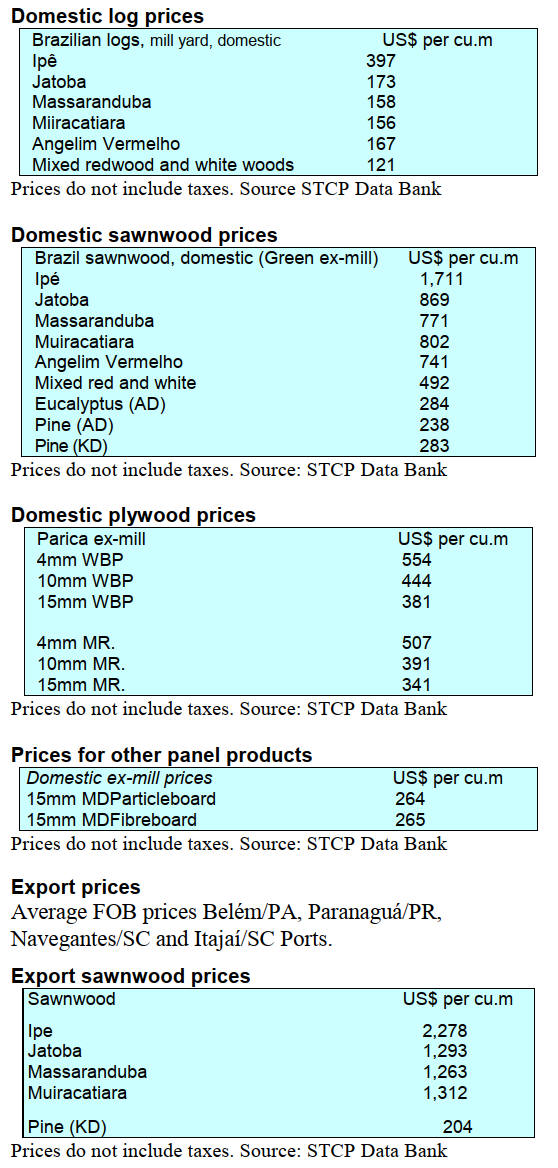

Through the eyes of industry
The latest GTI report lists the challenges identified by the
private sector in Brazil.
See: https://www.itto-
ggsc.org/static/upload/file/20250716/1752653872183995.pdf
9. PERU
Buyer trade mission to
Pucallpa
A recent business breakfast between buyers and exporters,
the main event of a timber buyers' mission to Pucallpa,
was a success. It brought together key players in regional,
national and international trade.
The event, which took place at the facilities of the Ucayali
Chamber of Commerce, Industry and Tourism (CCITU) in
the first half of June of this year, brought together more
than a dozen prominent value-added timber exporters from
the Ucayali region and buyers from Belgium, France,
Mexico, South Korea and Portugal.
"This business breakfast was a valuable platform for our
exporters to showcase their products and connect with
potential buyers in a business-friendly environment” said
the president of the Ucayali Chamber of Commerce,
Industry and Tourism.
Ucayali Chamber of Commerce and SERFOR awarded
lumber project
With the goal of contributing to quality education and at
the same time promoting the sustainable use of forest
resources, the Ucayali Chamber of Commerce, Industry
and Tourism led a project, with the technical support of
the National Forestry and Wildlife Service (SERFOR) and
the coordination of various stakeholders in the forestry
sector, to promote the project "Design and Construction of
a Modular Wooden Classroom Prototype at a School in the
Yarinacocha District, Coronel Portillo Province, Ucayali.
The project was approved by the Programa Nacional de
Desarrollo Tecnológico e Innovación (ProInnóvate) Board
of Directors with the Chamber of Commerce, Industry and
Tourism of Ucayali as the implementor along with the
National University of Ucayali, the Pucallpa Forestry
CITE and three Ucayali-based timber companies.
The classroom design incorporates criteria of efficiency,
sustainability and adaptation to climate change while also
promoting the use of new forest species for construction.
ADETOP algorithm to detect illegal logging
Peru is taking a technological leap forward in the defense
of its forests. On 15 July the Forest and Wildlife
Resources Oversight Agency (OSINFOR) presented
ADETOP v2, a new artificial intelligence algorithm for
detecting logging from space. Developed in conjunction
with the Universities of Sheffield and Cambridge, this
model represents a strategic innovation to strengthen forest
oversight and the fight against illegal logging in the
country.
The technical challenge was to develop an algorithm
capable of learning from forest information and adapting
to its social and ecological complexity. As an artificial
intelligence algorithm, ADETOP v2 uses the Random
Forest machine learning method. Therefore, it was fed
with information from Peruvian Amazonian forests,
collected by high-resolution drones used by OSINFOR
during monitoring work providing a real, validated and
reliable database.
Additionally, the system uses images from the Sentinel-2
satellite which offer a spatial resolution of ten metres and
captures the same point of interest every four days
allowing for frequent and detailed monitoring of the forest.
The combination of these elements is said to make
ADETOP v2 accurate in detecting selective logging in
Peru.
See: https://www.gob.pe/institucion/osinfor/noticias/1208816-
osinfor-lanza-adetop-v2-el-algoritmo-que-detecta-tala-ilegal-
desde-el-espacio
Strengthening forest management capacities of
regional governments
In order to promote the use of the "Gestiona Forestal" web
platform the National Forest and Wildlife Service (Serfor)
is strengthening the capacities of Amazonian regional
governments and forest agents who are responsible for
overseeing management plans to ensure timber traceability
and promote the sector's competitiveness.
Training sessions consisted of a theoretical and practical
component. Sessions included a simulation of Gestiona
Forestal (Forest Management Plan) for the proper
application of the process of formulating, evaluating and
approval of Forest Management Plans as well as their
various modalities for timber concessions, native and rural
communities and private properties.
The Director of Forest and Wildlife Asset Management
Control at Serfor reported that training sessions have been
held in Junín, Pasco and Huánuco. "It is crucial to advance
the process of strengthening the capacities of those
involved in the use of Gestiona Forestal (Forest
Management Plan).
One of the most advanced Departments in this practice is
Ucayali, whose authorities, as well as users and agents,
have successfully implemented this forestry tool”, the
Director emphasised.
See: https://www.gob.pe/institucion/serfor/noticias/1209382-
serfor-fortalece-las-capacidades-de-los-gore-y-regentes-para-uso-
de-la-plataforma-gestiona-forestal
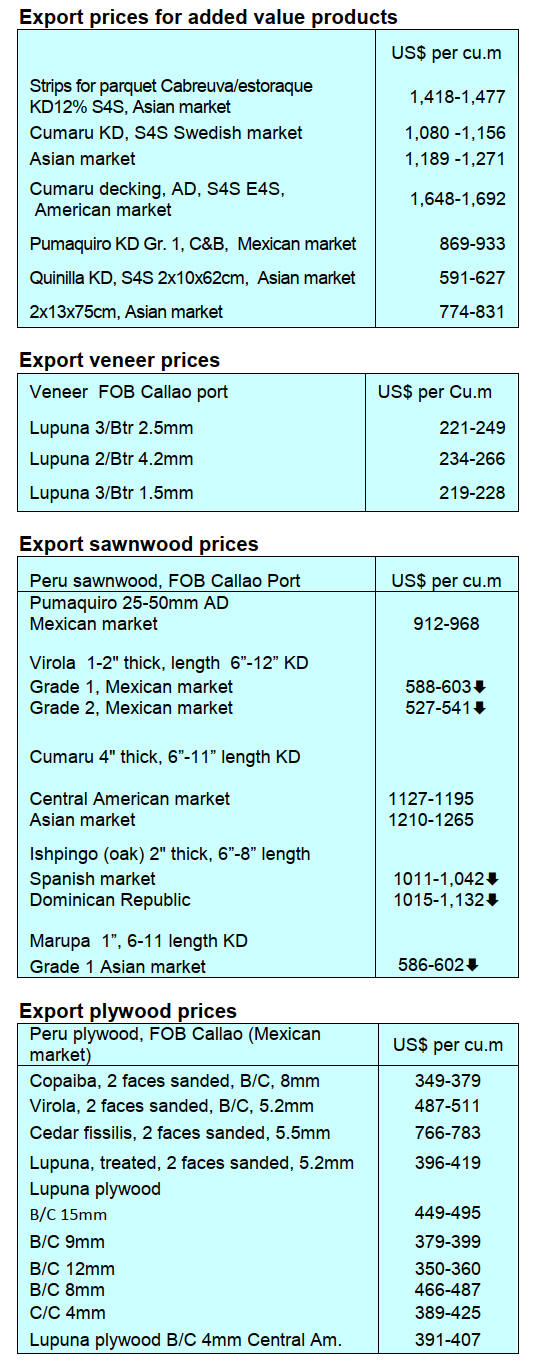
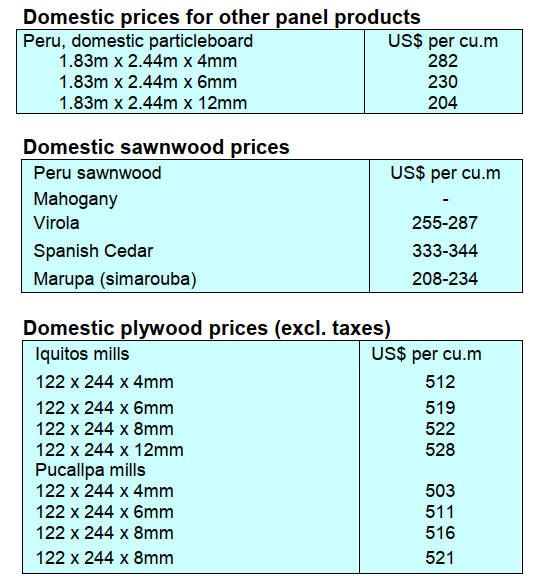
|